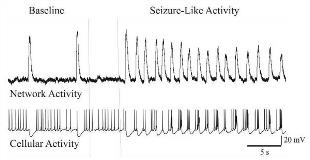ACTIVITY IN NEOCORTICAL MICRO-CIRCUITRY DURING SEIZURE-LIKE DISCHARGES: SYNCHRONIZATION AND RHYTHMICITY
Abstract number :
2.105
Submission category :
Year :
2003
Submission ID :
3744
Source :
www.aesnet.org
Presentation date :
12/6/2003 12:00:00 AM
Published date :
Dec 1, 2003, 06:00 AM
Authors :
Wim van Drongelen, Henner Koch, Jessica Loweth, Charles Marcuccilli, Fernando Pe[ntilde]a, Kurt Hecox, Jan-Marino Ramirez Pediatrics, The University of Chicago, Chicago, IL; Neurology, The University of Chicago, Chicago, IL; Organismal Biology and Anatomy
Hyper-synchrony and rhythmicity are frequently used to characterize EEG patterns during seizures. These terms suggest that underlying neural networks oscillate in a coordinated fashion, thus generating highly regular and rhythmic bursts of the field potential in the epileptic focus. The purpose of this study is to examine the scaling of synchrony and rhythmic activity at the neuronal level during onset of evoked seizure-like activity (SLA).
Coronal slices were made from somatosensory cortex of neonatal (P8-13) mice. Slices were transferred into a recording chamber and submerged in artificial CSF. Simultaneous recording of multi-unit action potential (AP) activity and intracellular recordings were used to study the relationship between neuronal activity and the surrounding network (Fig. 1).
We examined synchrony levels and rhythmic patterns during the transition to SLA that was evoked with 10 [mu]M bicuculline or 5 [mu]M NMDA.
The synchronous component of cellular AP activity was defined as the activity that is consistently locked with the network bursting. Asynchronous AP activity represents noise. To estimate both these components, spike trains were aligned with the onset of network bursts and we calculated the burst-related information as the difference between the total-entropy of these AP trains and noise-entropy across trials. AP intervals were determined before and after SLA onset. The interval relationship was inspected by constructing a two-dimensional return plot.
The return maps of the AP intervals show that the cellular discharges didn[rsquo]t become more rhythmic or structured, and frequently became more noise-like at SLA onset. Synchrony measures applied to the neuronal spike trains indicated that the increase of the synchrony level during SLA is either absent or modest.
Rhythmic bursting in the EEG activity is the hallmark of many types of ictal activity. Our observation during evoked SLA indicates that rhythmic activity doesn[rsquo]t scale to the level of the individual neurons. Assuming that the recorded neurons are representative for the whole population, we conclude that recruitment combined with modest levels of synchrony of the individual contributors play a major role in generation of bursting activity of the network during SLA (upper trace, Fig. 1). Similar low levels of synchrony observed in intra-operative recordings from patients with epilepsy during seizures indicate that the mechanisms observed during SLA may be important in ictogenesis.[figure1]
[Supported by: In part by a grant from the Falk Center]
